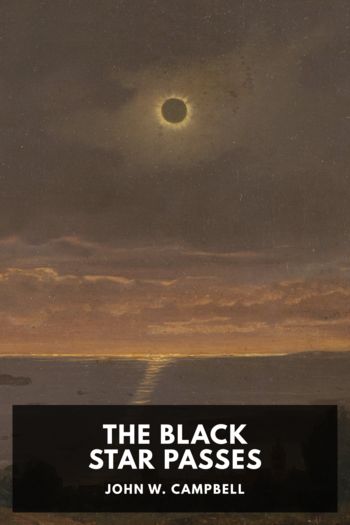Islands of Space - John W. Campbell (pdf to ebook reader TXT) 📗

- Author: John W. Campbell
Book online «Islands of Space - John W. Campbell (pdf to ebook reader TXT) 📗». Author John W. Campbell
Arcot spent the rest of the evening teaching them the Venerian system of telepathy.
They all rose at nine. Arcot got up first, and the others found it expedient to follow his example shortly thereafter. He had brought a large Tesla coil into the bedroom from the lab and succeeded in inducing sufficient voltage in the bedsprings to make very effective, though harmless, sparks.
“Come on, boys, hit the deck! Wade, as chief chemist, you are to synthesize a little coffee and heat-treat a few eggs for us. We have work ahead today! Rise and shine!” He didn’t shut off the coil until he was assured that each of them had gotten a considerable distance from his bed.
“Ouch!” yelled Morey. “Okay! Shut it off! I want to get my pants! We’re all up! You win!”
After breakfast, they all went into the room they used as a calculating room. Here they had two different types of integraph calculators and plenty of paper and equipment to do their own calculations and draw graphs.
“To begin with,” said Fuller, “let’s decide what shape we want to use. As designer, I’d like to point out that a sphere is the strongest, a cube easiest to build, and a torpedo shape the most efficient aerodynamically. However, we intend to use it in space, not air.
“And remember, we’ll need it more as a home than as a ship during the greater part of the trip.”
“We might need an aerodynamically stable hull,” Wade interjected. “It came in mighty handy on Venus. They’re darned useful in emergencies. What do you think, Arcot?”
“I favor the torpedo shape. Okay, now we’ve got a hull. How about some engines to run it? Let’s get those, too. I’ll name the general things first; facts and figures can come later.
“First: We must have a powerful mass-energy converter. We could use the cavity radiator and use cosmic rays to warm it, and drive the individual power units that way, or we can have a main electrical power unit and warm them all electrically. Now, which one would be the better?”
Morey frowned. “I think we’d be safer if we didn’t depend on any one plant, but had each as separate as possible. I’m for the individual cavity radiators.”
“Question,” interjected Fuller. “How do these cavity radiators work?”
“They’re built like a thermos bottle,” Arcot explained. “The inner shell will be of rough relux, which will absorb the heat efficiently, while the outer one will be of polished relux to keep the radiation inside. Between the two we’ll run a flow of helium at two tons per square inch pressure to carry the heat to the molecular motion apparatus. The neck of the bottle will contain the atomic generator.”
Fuller still looked puzzled. “See here; with this new space strain drive, why do we have to have the molecular drive at all?”
“To move around near a heavy mass—in the presence of a strong gravitational field,” Arcot said. “A gravitational field tends to warp space in such a way that the velocity of light is lower in its presence. Our drive tries to warp or strain space in the opposite manner. The two would simply cancel each other out and we’d waste a lot of power going nowhere. As a matter of fact, the gravitational field of the sun is so intense that we’ll have to go out beyond the orbit of Pluto before we can use the space strain drive effectively.”
“I catch,” said Fuller. “Now to get back to the generators. I think the power units would be simpler if they were controlled from one electrical power source, and just as reliable. Anyway, the molecular motion power is controlled, of necessity, from a single generator, so if one is apt to go bad, the other is, too.”
“Very good reasoning,” smiled Morey, “but I’m still strong for decentralization. I suggest a compromise. We can have the main power unit and the main verticals, which will be the largest, controlled by individual cosmic ray heaters, and the rest run by electric power units. They’d be just heating coils surrounded by the field.”
“A good idea,” said Arcot. “I’m in favor of the compromise. Okay, Fuller? Okay. Now the next problem is weapons. I suggest we use a separate control panel and a separate generating panel for the power tubes we’ll want in the molecular beam projectors.”
The molecular beam projector simply projected the field that caused molecular motion to take place as wanted. As weapons, they were terrifically deadly. If half a mountain is suddenly thrown into the air because all the random motion of its molecules becomes concentrated in one direction, it becomes a difficult projectile to fight. Or touch the bow of a ship with the beam; the bow drops to absolute zero and is driven back on the stern, with all the speed of its billions of molecules. The general effect is similar to that produced by two ships having a head-on collision at ten miles per second.
Anything touched by the beam is broken by its own molecules, twisted by its own strength, and crushed by its own toughness. Nothing can resist it.
“My idea,” Arcot went on, “was that since the same power is used for both the beams and the drive, we’ll have two separate power-tube banks to generate it. That way, if one breaks down, we can switch to the other. We can even use both at once on the drive, if necessary; the molecular motion machines will stand it if we make them of relux and anchor them with lux metal beams. The projectors would be able to handle the power, too, using Dad’s new system.
“That will give us more protection, and, at the same time, full power. Since we’ll have several projectors, the power needed to operate the ship will be about equal to the power required to operate the projectors.
“And I also suggest we mount some heat beam projectors.”
“Why?” objected Wade. “They’re





Comments (0)